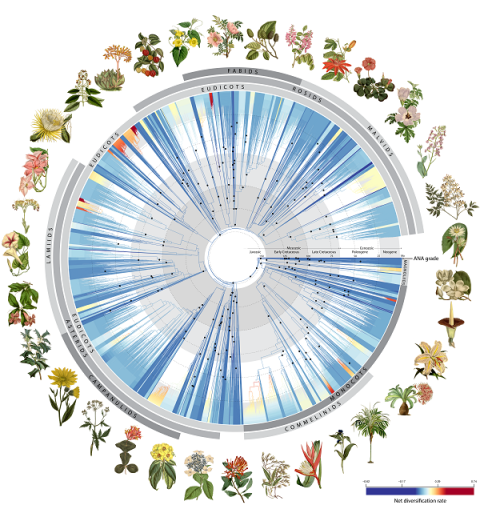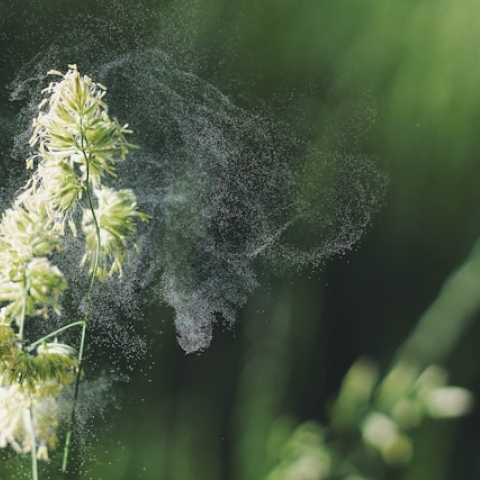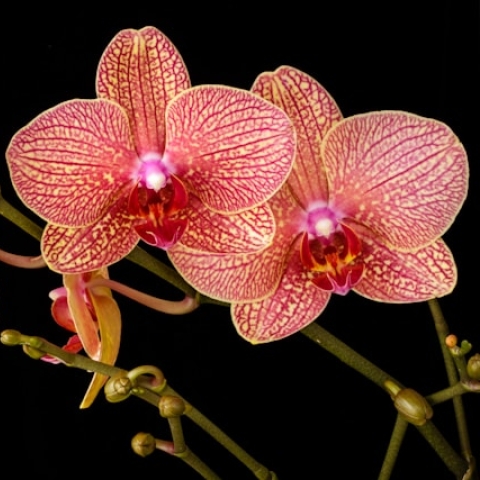

University of Portsmouth scientists are part of an international team to use 1.8 billion letters of genetic code to build groundbreaking tree of life.
24 April 2024
9
A new paper, published today in the journal Nature by an international team of 279 scientists, presents the most up-to-date understanding of the flowering plant tree of life.
Using 1.8 billion letters of genetic code from over 9,500 species covering almost 8,000 known flowering plant genera, this incredible achievement sheds new light on the evolutionary history of flowering plants and their rise to ecological dominance on Earth.
The study’s authors believe the data will aid future attempts to identify new species, refine plant classification, uncover new medicinal compounds, and conserve plants in the face of climate change and biodiversity loss.
The major milestone for plant science was led by Kew Gardens and involved 138 organisations internationally, including the University of Portsmouth. It was built on 15 times more data than any comparable studies of the flowering plant tree of life.
Among the species sequenced for this study, more than 800 have never had their DNA sequenced before. The sheer amount of data unlocked by this research, which would take a single computer 18 years to process, is a huge stride towards building a tree of life for all 330,000 known species of flowering plants – a massive undertaking by Kew’s Tree of Life Initiative.
Dr Alexandre Zuntini, Research Fellow at RBG Kew, said: “Analysing this unprecedented amount of data to decode the information hidden in millions of DNA sequences was a huge challenge. But it also offered the unique opportunity to reevaluate and extend our knowledge of the plant tree of life, opening a new window to explore the complexity of plant evolution.”
The flowering plant tree of life, much like our own family tree, enables us to understand how different species are related to each other. The tree of life is uncovered by comparing DNA sequences between different species to identify changes (mutations) that accumulate over time, like a molecular fossil record.
Our understanding of the tree of life is improving rapidly in tandem with advances in DNA sequencing technology. For this study, new genomic techniques were developed to magnetically capture hundreds of genes and hundreds of thousands of letters of genetic code from every sample, orders of magnitude more than earlier methods.
A key advantage of the team’s approach is that it enables a wide diversity of plant material, old and new, to be sequenced, even when the DNA is badly damaged.
The vast treasure troves of dried plant material in the world’s herbarium collections, which comprise nearly 400 million scientific specimens of plants, can now be studied genetically. Using such specimens, the team successfully sequenced a sandwort specimen (Arenaria globiflora) collected nearly 200 years ago in Nepal and, despite the poor quality of its DNA, were able to place it in the tree of life.
The team even analysed extinct plants, such as the Guadalupe Island olive (Hesperelaea palmeri), which has not been seen alive since 1875. In fact, 511 of the species sequenced are already at risk of extinction, according to the IUCN Red List, including three more like Hesperelaea that are already extinct.
Across all 9,506 species sequenced, over 3,400 came from material sourced from 163 herbaria in 48 countries. Additional material from plant collections around the world (e.g. DNA banks, seeds, living collections) have been vital for filling key knowledge gaps to shed new light on the history of flowering plant evolution. The team also benefited from publicly available data for over 1,900 species, highlighting the value of the open science approach to future genomic research.
Dr Steven Dodsworth and Dr Natalia Przelomska from the School of Biological Sciences at the University of Portsmouth were part of the research team.
It is great to see such a major output from this large collaborative project, which strengthens our understanding of plant evolution.
Dr Steven Dodsworth, School of Biological Sciences at the University of Portsmouth
Dr Steven Dodsworth and Dr Natalia Przelomska from the School of Biological Sciences at the University of Portsmouth were part of the research team.
Dr Dodsworth said: “It is great to see such a major output from this large collaborative project, which strengthens our understanding of plant evolution.
“I was part of the initial team at Kew when the project started back in 2016, where we developed a new universal tool to sequence the DNA of (many) conserved genes from any flowering plant species. This had not been attempted before in this way, and it is exciting to see how the botanical community globally have since taken this up and, together with the core team at Kew, created such a vital resource.”
“Fundamental science like this underpins so much of the impact-driven research that we focus on and thus its value cannot be underestimated”, added Dr Przelomska.
“I also really enjoyed producing data in the lab: from whimsical waterlilies, rare orchids, and Madagascan succulents. I believe a real asset of this study lies in the strategy for data generation - it employs new technologies, while staying relatively cost effective and universal across flowering plants. As more plant species are studied, this will accommodate for easily adding more good quality branches to the existing tree.”
The flowering plant tree of life has enormous potential in biodiversity research. This is because, just as one can predict the properties of an element based on its position in the periodic table, the location of a species in the tree of life allows us to predict its properties. The new data will thus be invaluable for enhancing many areas of science and beyond.
To enable this, the tree and all of the data that underpin it have been made openly and freely accessible to both the public and scientific community, including through the Kew Tree of Life Explorer.
More like this...
Pollen is a promising sustainable tool in the bone regeneration process
3 April 2024
7

Study shows orchid family emerged in northern hemisphere and thrived alongside dinosaurs
23 February 2024
8

Building waste could be used to grow tomatoes
Highly processed building waste, which usually ends up in landfill, can be used to grow tomatoes, a study from the University of Portsmouth has found.
12 October 2023
5 min read

